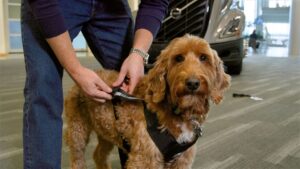Commercial Truck Trader recently published a guide to cab safety detailing how drivers can practice to keep themselves safe inside the truck.
Those tips range from being clutter free to regulating certain habits while driving
Keep your cab clutter-free
It’s common for many drivers to make their trucks more “home-like” or convenient by putting items on the dash, but it’s a bad idea. These may potentially limit your visibility, and in a crash, they can become deadly projectiles. Any loose objects should be stowed securely for your safety.
Wear your seatbelt at all times
In a crash, seatbelts help prevent you being thrown around the cab, or even worse, ejected from the truck, which can be fatal. If your truck has cabin airbags, the seatbelt keeps you in the proper position so a deploying airbag will help you; otherwise, it could potentially injure you. Wear the seatbelt correctly with the shoulder belt across your chest and shoulder. If you tuck it under your arm, it can break your ribs in a crash.
If you bring your pet, keep it secure
Many drivers like to take along a pet, but it’s dangerous to let them ride unsecured. They can be badly injured in a crash; and even if they aren’t, a frightened pet could bolt into traffic when a door is opened, or become territorial and refuse to let a first responder look after you. If you’re bringing a pet on the road, make sure they are in a harness that buckles into the seatbelt or in a secured crate or carrier.
Wear the right clothing
Loose and comfortable clothing can be an important safety item, because you’re paying attention to the road rather than fidgeting with your clothes. Take your coat off before you get into the truck, as it can be dangerous to take it off while you’re driving.
Set the right cabin temperature
If the heat’s too high, it can make you drowsy. In bad weather, ensure that your climate system is set to defrost. It’s not unusual for windows to fog up gradually, and you may think it’s simply hazy outside when in fact it’s your fogged windows that are obstructing your vision.
Replace your wiper blades regularly
New wiper blades are cheap safety insurance. Replace them whenever they start to streak, chatter, or don’t clean the entire sweep. Don’t wait until they’re cracked or torn before you get new ones. Ensure your washer fluid reservoir is always full, including in summertime when bugs or road grime can cause issues.
Install a dash cam if you don’t already have one
A dash cam is your electronic witness when something happens, especially in situations such as a driver who cuts you off and causes a crash, but then takes off to leave the destruction behind. It can also help document incidents involving unsecured freight or road hazards. Get one with high-enough resolution that it’s able to accurately record license plates or other vehicle details.
Regulate your radio
Don’t have it so loud that you can’t hear sirens, or that it’s distracting. If you listen to talk radio, make sure you aren’t so immersed that you’re concentrating on it, rather than your driving; or that you get angry or upset by what you’re hearing.
Minimize eating in your truck
If possible, park your truck and go inside the truck stop restaurant. It’s a break from driving, and you can stretch your legs and concentrate on enjoying your meal. It’s distracting to unwrap and eat fast food in your truck while you’re on the road. It’s good to have healthy snacks on hand between stops, but it’s easier to eat them if they’re in a plastic container, rather than if you have to dig into a bag for them.
Keep a clear head
Impaired driving doesn’t just involve alcohol. Many prescription or over-the-counter drugs can make you drowsy or affect your perception, including those for cold symptoms or nausea. Consult with your doctor, and read the warnings on drug packages to make sure they’re not going to interfere with your ability to drive safely.
Use your cell phone wisely
Stash your phone in a proper holder, and if possible, operate it through the truck’s infotainment system so it’s hands-free. Calling loved ones can make the miles go by, but if you think any call might become confrontational, wait until you’re stopped and can devote your attention to it. Otherwise, your anger will show through in your driving. If you use your phone for GPS maps, look for a truck-specific application. These will help route you to avoid low bridges or hairpin turns.
Distracted driving can be dangerous, and cellphones are one of the biggest culprits. To stay safe, stash your phone away while driving.
Watch where you’re looking
Always look as far ahead as possible – right to the horizon, if you can. This gives you a full view of what’s ahead, including any issues, and gives you more time to avoid problems when necessary.
Don’t sweat the small stuff
You’re sharing the road with many people who aren’t the best drivers, and you can’t let them get the better of you. If someone makes a dumb move, feel free to shout your favorite profanity in the confines of your cab, but then immediately let it go. Nothing can change what happened, and sparking road rage will make everything worse. Instead, breathe deep and think of something that makes you smile. It takes practice, but it’s worth it for your safety and that of everyone on the road.
Bruce Guthrie is an award-winning journalist who has lived in three states including Arkansas, Missouri and Georgia. During his nearly 20-year career, Bruce has served as managing editor and sports editor for numerous publications. He and his wife, Dana, who is also a journalist, are based in Carrollton, Georgia.















